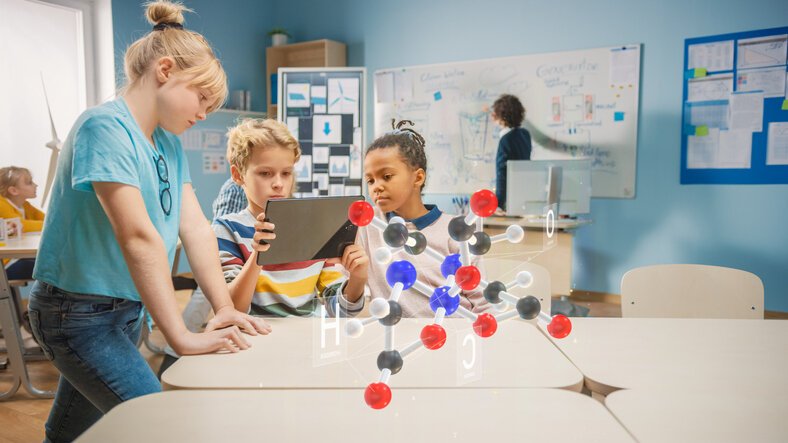The world is changing, and this also applies to the educational system. Students’ learning experiences are being improved and traditional teaching approaches are being revolutionized by technology.
In education, augmented reality
A potent tool in education is augmented reality (AR), a technology that superimposes digital content on the physical world. Augmented reality in learning offers a multitude of benefits that change the way students interact with educational content by fusing virtual aspects with the real environment. The potential of augmented reality in education to promote interactive learning, increase student engagement, and better knowledge retention will be discussed in this article’s nine benefits.
Augmented reality (AR) revolutionizes traditional education by offering enhanced interactive learning experiences. Unlike passive learning methods, AR enables students to actively engage with the subject matter through immersive and interactive elements. For example, in science classes, AR can bring complex scientific concepts to life by allowing students to visualize three-dimensional models of molecules or explore virtual environments simulating scientific phenomena.
With this practical approach, students can engage in meaningful and tangible interactions with the material while also fostering curiosity and investigation. Because AR allows students to participate in group activities where they must cooperate to solve puzzles or finish virtual simulations, it also fosters collaborative learning. The interactive aspect of augmented reality (AR) in the classroom not only increases student involvement but also improves comprehension and memory.
The following are just a few of the advantages that augmented reality has to offer schooling.
1.] Improved engagement with the curriculum
Students yearn for more engaging and interactive learning opportunities because traditional classroom environments frequently rely on passive learning techniques. However, augmented reality offers more interactive learning options, which dynamically changes the educational landscape. AR makes abstract concepts accessible by integrating virtual elements and empowering students to actively engage with the material. For example, allowing students to perceive three-dimensional models or conduct virtual experiments in science lectures is one way that augmented reality (AR) might make complicated scientific phenomena come to life.
Through hands-on manipulation and interaction with virtual objects, students are able to enhance their comprehension of the subject matter and develop their critical thinking, problem-solving, and curiosity abilities. As students participate in group activities and simulations and work together to investigate and solve problems, the immersive and interactive quality of augmented reality (AR) not only piques their attention but also fosters collaboration. Augmented reality paves the path for deeper comprehension and information acquisition by enabling students to take an active role in their own education through improved interactive learning experiences.
2.] Heightened involvement of students
The potential of augmented reality to greatly boost student engagement in the classroom is one of its main advantages. Sometimes traditional textbooks and lectures are unable to hold students’ interest, leading to passive learning. But using augmented reality in the classroom changes the process by bringing students into a dynamic, engaging environment. Augmented Reality (AR) brings subjects to life by superimposing digital content onto the actual world, increasing learner engagement and enjoyment.
AR can be used to enhance history courses by giving students the opportunity to digitally explore historical sites or experience key historical events in real time in a 360-degree immersive environment. Students are motivated by this degree of interaction and participation, which also helps with longer-term memory retention and greater understanding of the subject matter. By bridging the gap between the real and virtual worlds, augmented reality (AR) opens up new avenues for learning and gives students the confidence to actively engage in and take charge of their education.
3.] Enhanced retention of knowledge
The problem of knowledge retention in the classroom may be solved with the help of augmented reality. Because students may find it difficult to make the connection between abstract concepts and practical applications, traditional teaching approaches sometimes fail to assure long-term retention of information. AR, on the other hand, offers a multimodal learning environment that improves memory recall and retention.
Augmented Reality (AR) helps students create better associations and mental connections with the subject matter by picturing complicated ideas through contextualized and interactive virtual aspects. Studies have demonstrated that, in contrast to conventional techniques, the combination of visual and audio inputs in augmented reality greatly enhances knowledge memory. Students are more likely to remember what they have learned over time when they are able to view and interact with virtual items that are connected to the material they are studying. Teachers may help kids retain material better and develop a strong foundation of learning that goes beyond the classroom by utilizing augmented reality (AR).
4.] Improved engagement with the curriculum
AR makes abstract topics concrete by fusing virtual and real-world aspects. This encourages students to actively engage with the material. Students can improve critical thinking, problem-solving abilities, and comprehension through interactive encounters with virtual objects and realistic simulations. Students are motivated and given more authority in a dynamic learning environment that is created by this interactive approach, which piques curiosity and promotes teamwork.
5.] Individualized education
Customized learning experiences that are suited to each student’s needs are made possible via augmented reality. AR can offer specialized help and challenges by modifying interactions and content according to a student’s development and skill level. AR is capable of accommodating varying learning styles, speeds, and preferences with its customizable virtual settings and adaptive feedback. Learning results are improved through increased student engagement and comprehension as a result of this individualized strategy.
6.] Practical implementation
Augmented Reality’s (AR) potential to close the knowledge gap between classroom instruction and practical application is one of its many impressive educational benefits. With AR, virtual elements are superimposed on actual locations, allowing students to make connections between theoretical knowledge and real-world applications. AR immerses students in authentic experiences, preparing them for future vocations and real-life difficulties, whether they are performing medical operations on virtual patients or studying architecture through virtual building design.
7.] Both inclusivity and accessibility
The integration of augmented reality in education fosters inclusion by providing accessibility features and meeting the demands of a wide range of learners. Students with various learning styles or disabilities can benefit from the audio cues, visual aids, and multisensory feedback that augmented reality (AR) can offer. Through the elimination of physical obstacles and the provision of substitute modes of content interaction, augmented reality guarantees that every student may engage fully and reap the rewards of the educational process. For all students, this inclusive approach creates a supportive and empowering learning environment.
8.] International and cultural viewpoints
With augmented reality, students can access global and cultural perspectives regardless of where they are in the world. Without ever leaving the classroom, augmented reality (AR) enables students to learn about and experience many cultures, languages, and nations through virtual travel, language translations, and interactive cultural exhibitions. Students are better equipped to prosper in a globalized society by being exposed to a variety of cultures, which promotes empathy, cultural awareness, and global citizenship.
9.] Motivation and gamification
With the use of gamification components, augmented reality has the ability to make learning more interesting and inspiring. Through the use of game-like elements like achievements, challenges, and progress monitoring, augmented reality (AR) may make learning entertaining and promote healthy competition among students. Because students are motivated by the desire to complete tasks, get badges, or advance to higher levels, gamification in education through augmented reality (AR) fosters intrinsic motivation. Students’ motivation, perseverance, and general enjoyment of the learning process are all increased by this gamified method.
The lesson learned
Through the provision of more interactive learning experiences, heightened student engagement, and improved knowledge retention, augmented reality is revolutionizing the educational landscape. It is clear from real-world applications of augmented reality in education that AR has the power to completely transform traditional education, making it more engaging, dynamic, and efficient. Teachers have the chance to design dynamic learning environments that equip students for the opportunities and challenges of the future as they adopt this technology and take use of its advantages. We can usher in a new era of education that encourages creativity, critical thinking, and lifelong learning by utilizing AR in the classroom.




